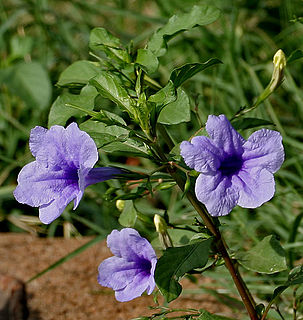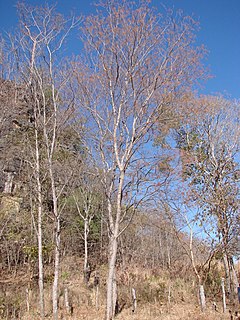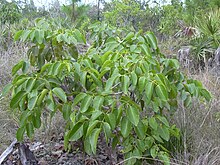
Anacardium, the cashews, are a genus of flowering plants in the family Anacardiaceae, native to tropical regions of the Americas.

Aleurites is a small genus of arborescent flowering plants in the Euphorbiaceae, first described as a genus in 1776. It is native to China, the Indian Subcontinent, Southeast Asia, Papuasia, and Queensland. It is also reportedly naturalized on various islands as well as scattered locations in Africa, South America, and Florida.

Thespesia is a genus of 13 flowering shrubs and trees in the Hibiscus family, Malvaceae, although within the family they are more closely related to cotton plants (Gossypium). The genus is distributed from the South Pacific through Asia, Africa, and the Caribbean.

Bombax is a genus of mainly tropical trees in the mallow family. They are native to western Africa, the Indian subcontinent, Southeast Asia, and the subtropical regions of East Asia and northern Australia. It is distinguished from the genus Ceiba, which has whiter flowers.

Schinus is a genus of flowering trees and tall shrubs in the sumac family, Anacardiaceae. Members of the genus are commonly known as pepper trees. The Peruvian pepper tree is the source of the spice known as pink peppercorns. Some species have become an invasive species outside their natural habitats. Schinus polygama, although less well known, is also potentially weedy in mesic areas.

Gouania is a genus of flowering plants in the family Rhamnaceae. The 50 to 70 species it contains are native to tropical and subtropical regions of the world, including Africa, Madagascar, the Indian Ocean islands, southern Asia, the Americas and Hawaii. They are shrubs or lianas. A revision of the species in Madagascar and the other western Indian Ocean islands is in preparation, where the genus has an important centre of diversity. The work will recognise several new species.

Nyctaginaceae, the four o'clock family, is a family of around 33 genera and 290 species of flowering plants, widely distributed in tropical and subtropical regions, with a few representatives in temperate regions. The family has a unique fruit type, called an "anthocarp", and many genera have extremely large pollen grains.

Ruellia is a genus of flowering plants commonly known as ruellias or wild petunias. They are not closely related to petunias (Petunia) although both genera belong to the same euasterid clade. The genus was named in honor of Jean Ruelle (1474–1537), herbalist and physician to Francis I of France and translator of several works of Dioscorides.

Pimenta is a genus of flowering plants in the myrtle family, Myrtaceae described as a genus in 1821. It is native to Central and South America, Mexico, and the West Indies.

Iresine is a genus of flowering plants in the family Amaranthaceae. It contains 20 to 25 species, all of which are native to the American tropics. The generic name is derived from the Greek word εριος (erios), meaning "wooly", referring to the trichome-covered flowers. Bloodleaf is a common name for those species that have colored foliage, and these are often cultivated as ornamental plants. Some species are additives to versions of the hallucinogenic drink ayahuasca.

Astronium is a genus of flowering plants in the cashew family, Anacardiaceae. It is native to Central and South America.

Myracrodruon is a genus of plants in the family Anacardiaceae. Species are native to South America.

Lithraea is a genus of three species of flowering plants in the cashew family, Anacardiaceae. It is native to Argentina, Bolivia, Brazil, Chile, Paraguay, and Uruguay. They are dioecious trees with poisonous sap that can induce contact dermatitis.

Metopium toxiferum, the poisonwood, Florida poisontree, or hog gum, is a species of flowering tree in the cashew or sumac family, Anacardiaceae, that is native to the American Neotropics. It produces the irritant urushiol much like its close relatives poison sumac and poison oak. It is related to black poisonwood.

Amyris is a genus of flowering plants in the citrus family, Rutaceae. The generic name is derived from the Greek word αμυρων (amyron), which means "intensely scented" and refers to the strong odor of the resin. Members of the genus are commonly known as Torchwoods because of their highly flammable wood.
Schaefferia is a genus of flowering shrubs and small trees in the family Celastraceae. The generic name honours German mycologist and clergyman Jacob Christian Schäffer (1718–1790). Members of the genus are found in the Neotropics. The plants are dioecious, with flowers that are unisexual by abortion. The flowers are usually clustered in the leaf axil, although they are solitary in some species. The calyx of the flowers has four lobes, and the corolla consists of four petals. The ovary consists of two locules; each locule has a single ovule which develops into a single seed. The fruit is a drupe.

Waltheria is a genus of flowering plants in the mallow family, Malvaceae. It is sometimes placed in Sterculiaceae. The name honours German botanist Augustin Friedrich Walther (1688–1746).

Anacardioideae is a subfamily of plants in the family Anacardiaceae.

Holigarna is a genus of trees in the subfamily Anacardioideae of the cashew and sumac family Anacardiaceae. They grow naturally in India, Bangladesh and Indo-China. This is a poisonous tree; if contacted, it would irritate skin chemically and result in irreversible skin damage. Smoke from burning this wood is dangerously disabling.
Mosquitoxylum is a monotypic genus of trees in the subfamily Anacardioideae of the cashew and sumac family Anacardiaceae. It contains the single species Mosquitoxylum jamaicense, which grows naturally from southern Mexico to Ecuador and also in Jamaica.


















